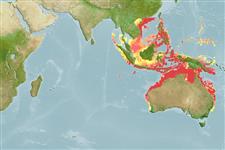Classification / Names
Common names from other countries
Main reference
Size / Weight / Age
Max length : 50.0 cm SL male/unsexed; (Ref. 3397); common length : 30.0 cm TL male/unsexed; (Ref. 5450); max. reported age: 7 years (Ref. 94612)
Length at first maturity
Lm 19.8 range ? - ? cm
Environment
Marine; reef-associated; amphidromous (Ref. 51243); depth range 1 - 350 m (Ref. 38189)
Climate / Range
Subtropical, preferred 27°C (Ref. 107945); 45°N - 44°S, 89°E - 154°E
Distribution
Eastern Indian Ocean, Malay Peninsula, southern Philippines, northern Java, Arafura Sea, Louisiade Archipelago, and northern half and southwestern Australia. Reports of Introduction in the Mediterranean are questionable. Confirmed and questionable reports of its occurrence (and references) are discussed in Inoue & Nakabo 2006 (Ref. 57869:385-6).
Countries | FAO areas | Ecosystems | Occurrences | Introductions
Short description
Dorsal
spines
(total): 0;
Dorsal
soft rays
(total): 11-12;
Anal
spines: 0;
Anal
soft rays: 11 - 12. Cigar-shaped, rounded or slightly compressed; the head pointed and depressed; the snout rounded. Dorsal origin closer to the adipose origin than the snout tip. Anal fin origin is closer to the tail base than the operculum. Color is brown-gray above and creamy below, with 8-10 indistinct darker spots along the middle of the sides.
IUCN Red List Status (Ref. 115185)
Threat to humans
Harmless
Human uses
Fisheries: minor commercial
Tools
Special reports
Download XML
Internet sources
Estimates of some properties based on models
Phylogenetic diversity index
PD50 = 0.5000 many relatives (e.g. carps) 0.5 - 2.0 few relatives (e.g. lungfishes)
Trophic Level
4.5 ±0.4 se; Based on diet studies.
Resilience
Medium, minimum population doubling time 1.4 - 4.4 years (K=0.3-0.9; tm=1-2; tmax=8)
Vulnerability
Low to moderate vulnerability (31 of 100)
Price category
